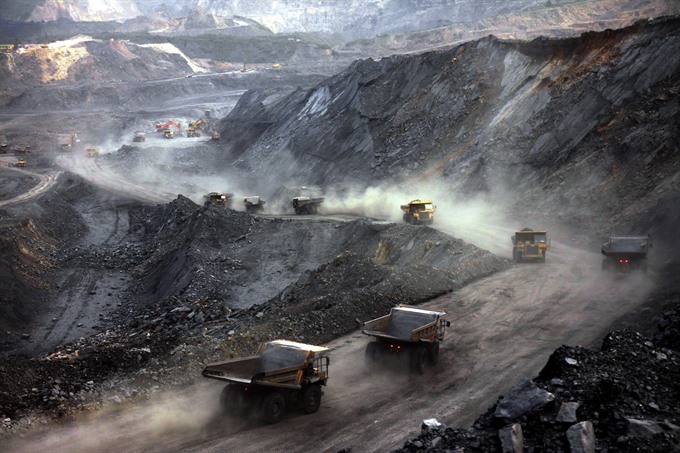 Economy
Economy

Việt Nam’s coal sector is facing decreasing exports and competition from imported coal, Nguyễn Khắc Thọ, deputy director of the General Directorate of Energy under the Ministry of Industry and Trade, said yesterday at a conference in Hà Nội on coal imports and ensuring national energy security.
 |
| Tây Nam Đá Mài Coal Mine of Việt Nam National Coal – Mineral Industries Holding Corporation Limited in northern Quảng Ninh Province. The coal industry faces decreasing exports and fierce competition from imported coal. – VNA/VNS Photo Trọng Đạt |
HÀ NỘI – Việt Nam’s coal sector is facing decreasing exports and competition from imported coal, Nguyễn Khắc Thọ, deputy director of the General Directorate of Energy under the Ministry of Industry and Trade, said yesterday at a conference in Hà Nội on coal imports and ensuring national energy security.
Việt Nam, previously a coal exporter, imported 10.5 million tonnes of coal in the first nine months of the year, a 147 per cent year-on-year, mostly from China, Russia and Australia.
Thọ told participants that the coal industry’s target was to effectively serve local demand. However, the sector has faced difficulties due to the sharp and prolonged decrease of coal prices on world markets.
“In adition, the sector has seen increasing costs of exploitation and transport. The coal exploitation has not met with higher demand as thermo-electricity plants come into effect,” Thọ said.
Nguyễn Văn Biên, deputy general director of Việt Nam National Coal and Mineral Industries Group (Vinacomin), said coal prices have been on the decline because of the global financial crisis and slow consumption. At the same time, local coal producers have not met demands for clean coal for thermo-electricity and coal-fired plants, he said, adding that this was why coal imports in Việt Nam are on the rise.
Biên said Vinacomin had to reduce costs while improving administration to reduce spending.
This year, Vinacomin’s coal output was 26.7 million tonnes, meeting 67 per cent of the annual target. The coal consumption was 25.7 million tonnes or 80 per cent of the total this year.
However, the coal inventory has been at a high level of 10.8 million tonnes while the country lacks clean coal for local household consumption, he said.
He added that taxes and fees on coal production have been continuously increased in the past few years. The tax on natural resources has been 7 to 10 per cent higher than those in other countries in the region while the tax on imported coal was zero.
“The cheap imported coal has put pressure on the domestic producers, forcing Vinacomin to reduce production and labourers,” he said.
Thọ said coal imports were needed for electricity production to meet economic development demand while ensuring energy security.
According to a new master development plan for the coal sector by 2020, with a vision towards 2030, Việt Nam would have to import a large amount of coal for thermo-electricity plants next year and imports would surge after 2020.
He also said the ministry had adjusted its estimate of the total capital demand of the domestic coal sector by 2030 to around VNĐ269 trillion (US$11.9 billion), 2.5 times less compared with the previous master plan.
The adjusted plan prioritises meeting local coal demand while gradually reducing exports.
Tax reduction proposal nixed
Meanwhile, Deputy Minister of Finance, Vũ Thị Mai, informed Vinacomin and the northern Quảng Ninh Province that their proposal to reduce the coal export tax had been rejected.
Mai said the tax reduction was not consistent with current economic circumstances. The natural resources tax on coal has been at 10-12 per cent.
The deputy minister added that Vinacomin’s major coal supplies come from three big mines in Quảng Ninh including Vàng Danh, Uông Bí and Năm Mẫu.
More than 30 per cent of the total output was high quality coal, while imported coal prices were lower than domestic ones, leading electricity and cement plants to reduce their coal purchase from Vinacomin.
The ministry proposed the MoIT adjust the coal export plan in the 2017-20 period from two tonnes a year to three or four in order to ease the group’s difficulties.
“This is a feasible solution in comparison with tax reduction as this could help reduce inventory,” she said.
Vedan Việt Nam Company and Hưng nghiệp Formosa Company in the southern Đồng Nai Province have submitted to the Government a plan to directly import coal for electricity production instead of buying coal from local producers. The companies said domestic coal is not suited to their equipment and technologies for power generation.
The coal sector’s decreasing exports are threatening thousands of labourers. Vinacomin announced cuts of more than 4,000 jobs due to declining turnover and profit. -- VNS




